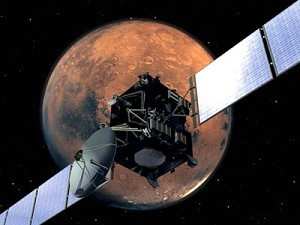Building Momentum For Comet Rendezvous
 The European Space Agency's comet
chaser, Rosetta, is on its way to its second close encounter with
Earth next Tuesday. The spacecraft's operators are leaving no
stones unturned to make sure Earth's gravity gives it the exact
boost it needs en route to its destination.
The European Space Agency's comet
chaser, Rosetta, is on its way to its second close encounter with
Earth next Tuesday. The spacecraft's operators are leaving no
stones unturned to make sure Earth's gravity gives it the exact
boost it needs en route to its destination.
This month's Earth swing-by is Rosetta's third major step on its
10-year journey to 67/P Churyumov-Gerasimenko. The trajectory
correction maneuver successfully performed last month prepared
ESA's Comet Chaser for the upcoming encounter. ESA says the
spacecraft is right on track to gain the right amount of energy
from Earth's gravity, and save fuel later on.
Closest approach will take place on November 13 2007 at 21:57
CET, at which time Rosetta will speed past at 45,000 km/h (about
12.5 km/s) relative to Earth. At this time, Rosetta will be 5301 km
above the Pacific Ocean, south-west of Chile.
Swing-bys make use of the gravitational attraction of planets to
modify a spacecraft's trajectory and to gain the orbital energy
needed to reach the final target. The first Earth swing-by took
place on March 4, 2005. On February 25, 2007 Rosetta made its
closest approach to Mars, to use its gravity. The swing-by this
month will be followed by the third and last swing-by, using
Earth's gravity, in November 2009.
While the gravity-assist maneuver at Mars was needed to slow the
spacecraft down and head back towards the inner solar system, the
second Earth swing by will help Rosetta gain enough energy to reach
the outer Solar System through the asteroid belt and observe
asteroid Steins, one of its scientific targets. Rosetta will then
head back to Earth for the last planned swing-by in November
2009.
The increased energy from this Earth swing-by will help Rosetta
cross the asteroid belt for a second time, observe Lutetia (its
second target asteroid) and finally rendezvous with comet 67/P
Churyumov-Gerasimenko. The rendezvous will take place about 4
astronomical units or 600 million km from the Sun, in 2014.
 During this Earth swing-by, the
highest priority will be given to spacecraft operations, as the
maneuver is critical for the success of the overall mission. In
addition, during the incoming and outgoing tracks of the swing-by,
Rosetta will be under unfavorable solar illumination and thus
temperature conditions. This is why only very limited slots will be
available for the instruments to be used safely.
During this Earth swing-by, the
highest priority will be given to spacecraft operations, as the
maneuver is critical for the success of the overall mission. In
addition, during the incoming and outgoing tracks of the swing-by,
Rosetta will be under unfavorable solar illumination and thus
temperature conditions. This is why only very limited slots will be
available for the instruments to be used safely.
Despite this, a few experiments both on the orbiter and the
Philae lander will be activated for calibration, scientific
measurements and imaging. The observations are scheduled during and
around the time of closest approach.
Rosetta will first point to Earth to make observations of the
atmosphere and the magnetosphere, including a search for shooting
stars from space. It will image urban regions in Asia, Africa and
Europe and then point to the Moon and obtain spectra of the
illuminated Moon. Flying away after closest approach, Rosetta will
image the Earth-Moon system from a distance.
Rosetta will be controlled from ESA's Spacecraft Operations
Center (ESOC) in Darmstadt, Germany.
 ANN's Daily Aero-Term (05.19.24): Back-Taxi
ANN's Daily Aero-Term (05.19.24): Back-Taxi Aero-News: Quote of the Day (05.19.24)
Aero-News: Quote of the Day (05.19.24) Aero-News: Quote of the Day (05.20.24)
Aero-News: Quote of the Day (05.20.24) ANN's Daily Aero-Term (05.20.24): Blind Speed
ANN's Daily Aero-Term (05.20.24): Blind Speed ANN's Daily Aero-Linx (05.20.24)
ANN's Daily Aero-Linx (05.20.24)




